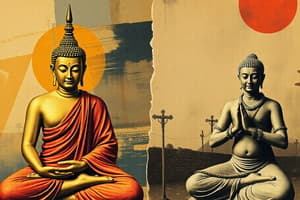Podcast
Questions and Answers
Who is credited with the origin of Buddhism?
Who is credited with the origin of Buddhism?
- Mahavira
- Ashoka
- Kanishka
- Gautama Buddha (correct)
What was the significance of the Buddhist Councils?
What was the significance of the Buddhist Councils?
- To establish the Satavahana dynasty
- To defeat the Kushanas
- To spread Buddhism to Central Asia
- To compile the teachings of Buddha (correct)
Which dynasty was known for its socio-cultural impact on Central Asia?
Which dynasty was known for its socio-cultural impact on Central Asia?
- The Satavahanas
- The Parthians
- The Shakas
- The Kushanas (correct)
What was the main focus of the Doctrines of Buddhism?
What was the main focus of the Doctrines of Buddhism?
Which emperor is known for his significant contribution to Buddhism?
Which emperor is known for his significant contribution to Buddhism?
Which of the following dynasties was not a part of the ancient Indian administration?
Which of the following dynasties was not a part of the ancient Indian administration?
What was the role of the Tribal Chief or Rajan in ancient Indian society?
What was the role of the Tribal Chief or Rajan in ancient Indian society?
What was the name of the queen in ancient Indian society?
What was the name of the queen in ancient Indian society?
What was the significance of the Sabha in ancient Indian society?
What was the significance of the Sabha in ancient Indian society?
What was the outcome of the Battle of Ten Kings?
What was the outcome of the Battle of Ten Kings?
Which tribe was dominant among the Aryans?
Which tribe was dominant among the Aryans?
What was the role of the Gana in ancient Indian society?
What was the role of the Gana in ancient Indian society?
What was the significance of the Vidatha in ancient Indian society?
What was the significance of the Vidatha in ancient Indian society?
What was the outcome of the alliance between the Kurus and Panchalas?
What was the outcome of the alliance between the Kurus and Panchalas?
Which of the following is a significant aspect of the Satavahana dynasty?
Which of the following is a significant aspect of the Satavahana dynasty?
What is a prominent feature of the Buddhist school of philosophy?
What is a prominent feature of the Buddhist school of philosophy?
Which of the following is NOT a reason for the decline of Buddhism?
Which of the following is NOT a reason for the decline of Buddhism?
What was an important aspect of the administration of the Satavahana dynasty?
What was an important aspect of the administration of the Satavahana dynasty?
Which of the following rulers is associated with the Satavahana dynasty?
Which of the following rulers is associated with the Satavahana dynasty?
What is a characteristic of the social organization of the Satavahana dynasty?
What is a characteristic of the social organization of the Satavahana dynasty?
Which of the following is NOT a characteristic of Buddhist literature?
Which of the following is NOT a characteristic of Buddhist literature?
What is a significant aspect of the language of the Satavahana dynasty?
What is a significant aspect of the language of the Satavahana dynasty?
Flashcards are hidden until you start studying
Study Notes
Buddhism and Jainism
- Origin of Buddhism and Jainism dates back to 6th century BCE
- Buddhism was founded by Gautama Buddha
- Buddhist doctrines include Four Noble Truths and Eightfold Path
Tribal Kingdoms
- Bharatas, Matsyas, Yadus, and Purus were tribal kingdoms of ancient India
- Tribal Chief or Rajan was the protector of his tribe, responsible for safeguarding cattle, leading wars, and performing religious duties
- The king's position appeared hereditary, but with some traces of election by the tribal assembly (samiti)
- Tribal assemblies like Sabha, Samiti, Vidatha, and Gana had deliberative, military, and religious roles
- Women could attend the Sabha and Vidatha
Military Structure and Conflicts
- The king did not maintain a standing army and relied on tribal units assembled during war
- Military functions were performed by tribal groups called Vrat, Gana, Grama, and Sardha
- Aryans were engaged in conflicts with pre-Aryans and had internal tribal disputes
- The Bharatas, led by Sudas, defeated a coalition of ten rulers (a mix of Aryan and non-Aryan leaders) in the Battle of Ten Kings (Dashrajna) on the banks of the Parushni (Ravi) river
The Satavahanas
- Buddhist Literature, Mudras, and School of Philosophy were prominent during this period
- Causes of the Decline of Buddhism include the rise of Brahmanism and rival religious movements
- Satavahana rulers were important in the region
- Material Culture of Satavahana included agriculture and economy
- Social Organisation, Administration, Religion, Architecture, Language, and Decline of the Empire were significant aspects of Satavahana rule
Kingdoms of South India
- Chalukyas, Pallavas, and Kadambas of Banavasi were prominent kingdoms in South India
Studying That Suits You
Use AI to generate personalized quizzes and flashcards to suit your learning preferences.




